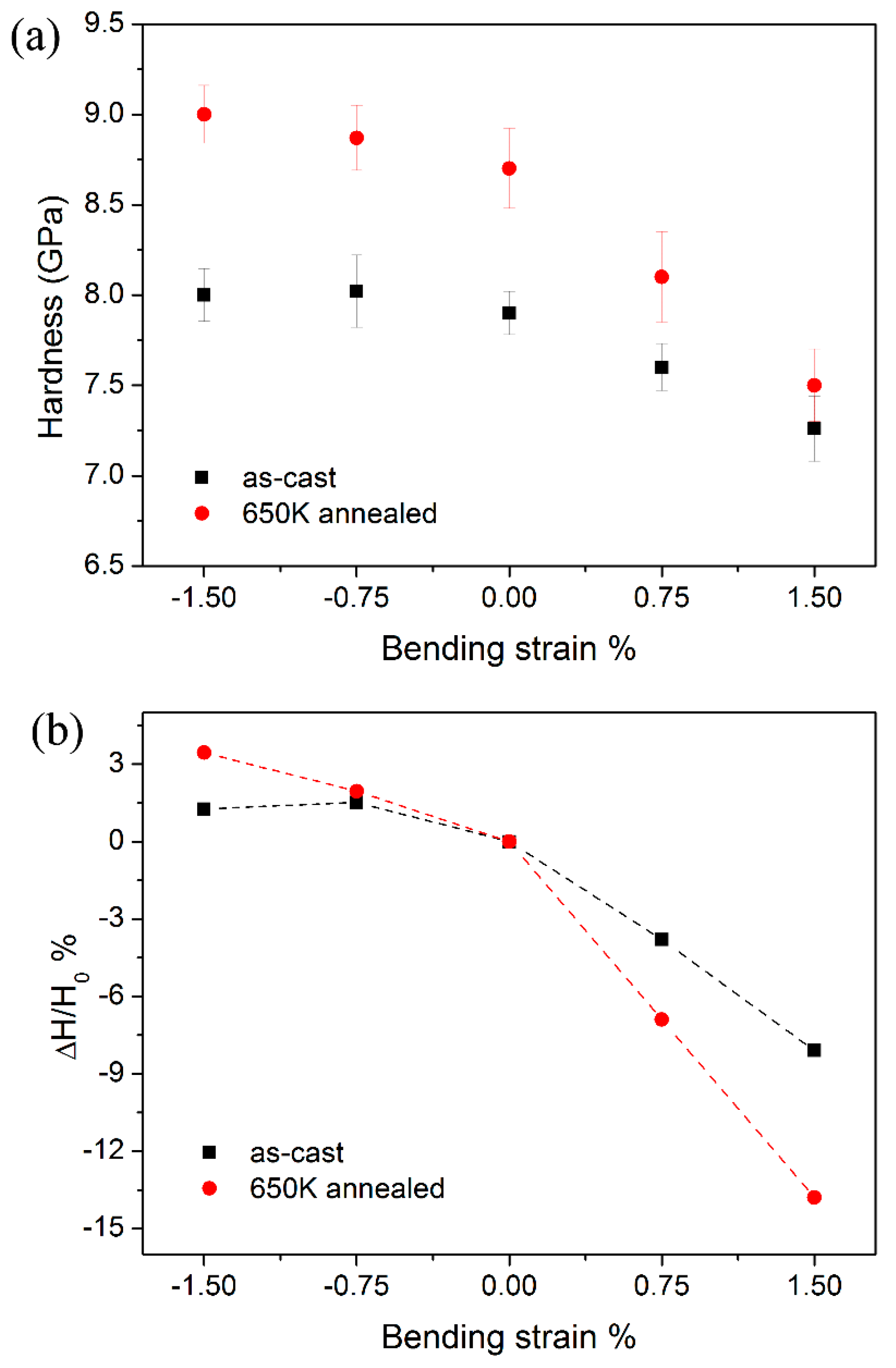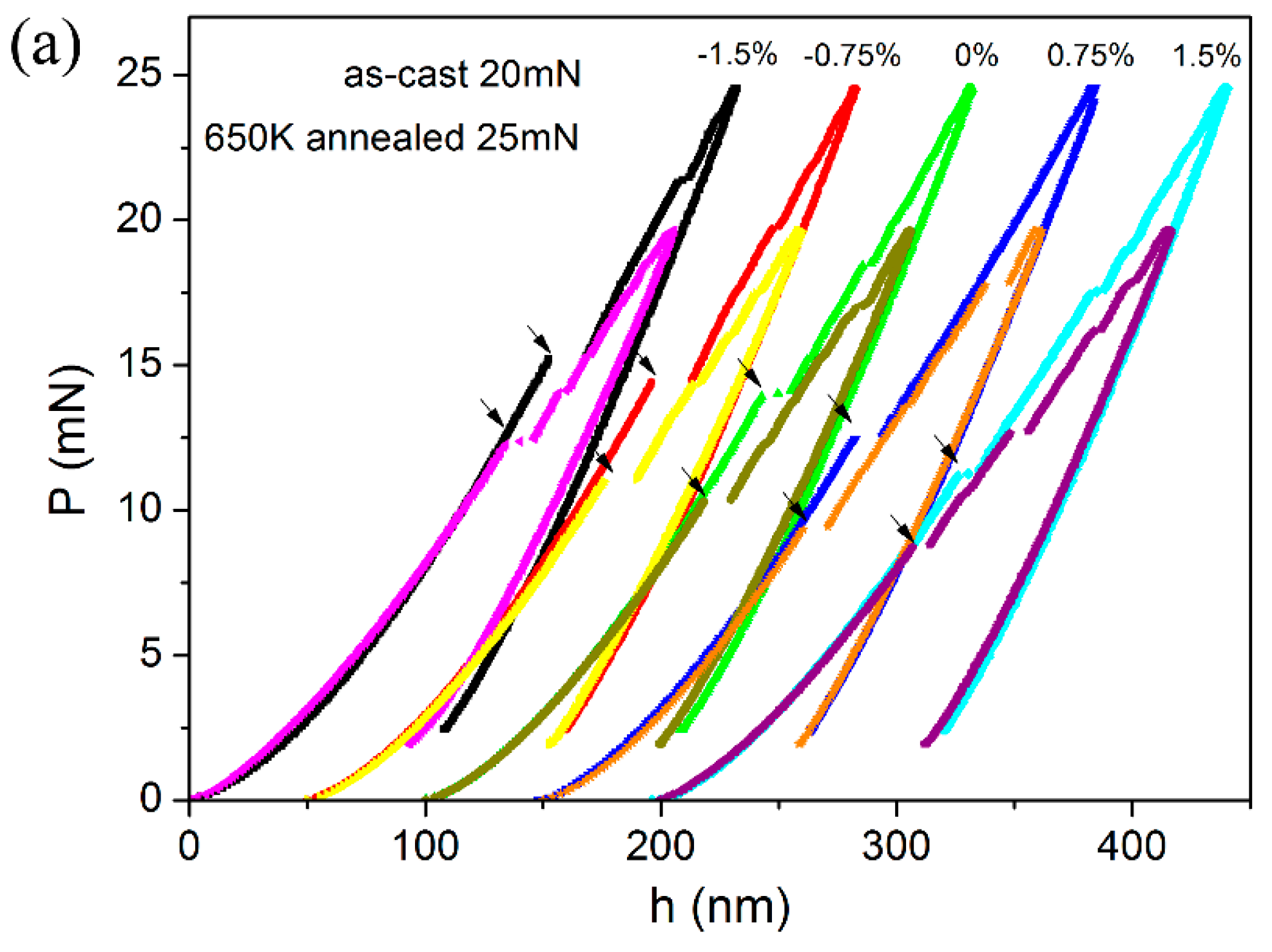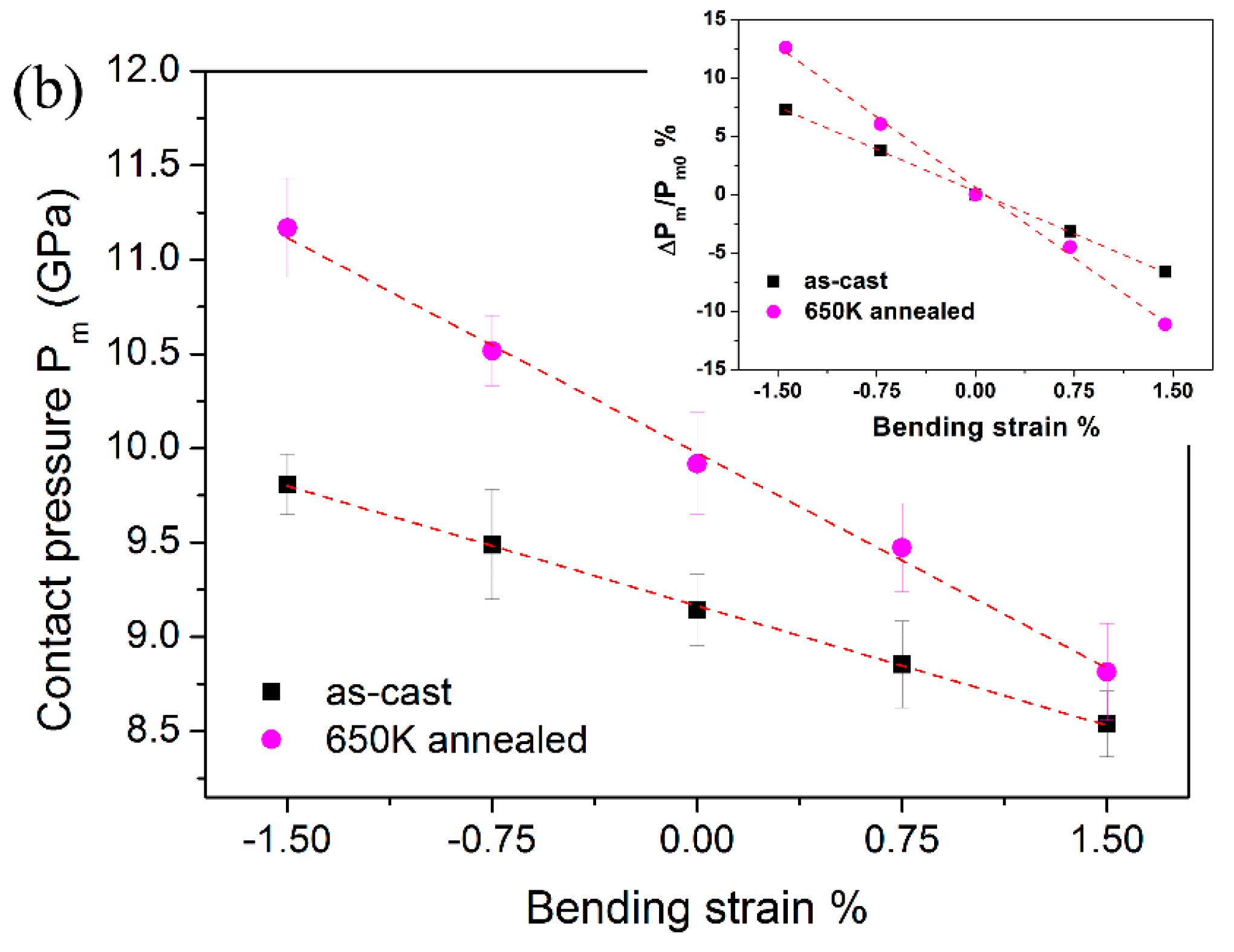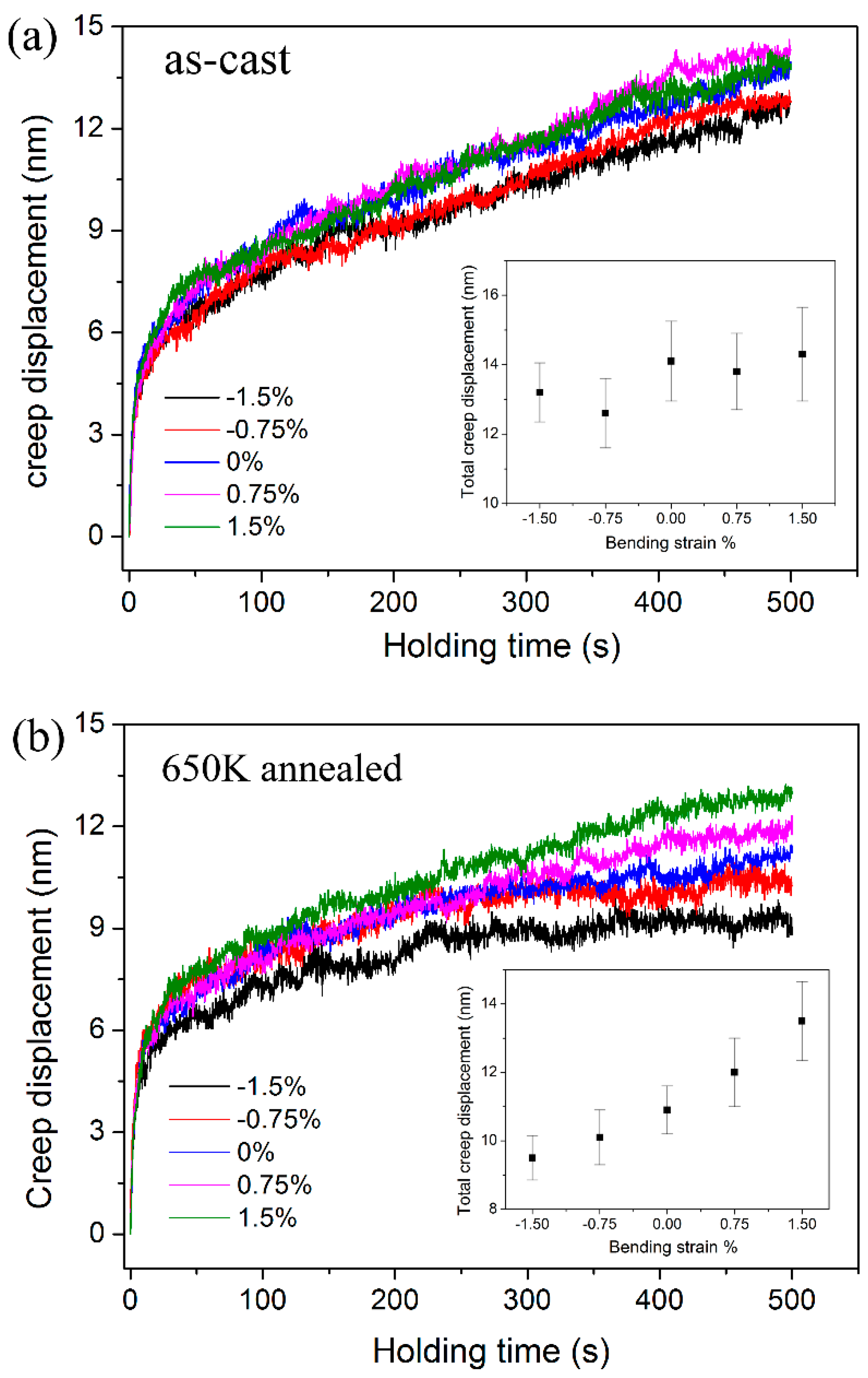Effect of Applied Stress on the Mechanical Properties of a Zr-Cu-Ag-Al Bulk Metallic Glass with Two Different Structure States
Abstract
:1. Introduction
2. Materials and Methods
3. Results and Discussion
3.1. Structure Characterization
3.2. Elastic Modulus and Hardness
3.3. Pop-in Shear Stress
3.4. Creep Behavior and Strain Rate Sensitivity
4. Conclusions
- (1)
- Hardness and the contact pressure for yielding evidently decreased with the application of tensile stress. At the compressive side, contact pressure enhancement was much more significant than hardness increase. Elastic modulus was unaffected by applied stress.
- (2)
- Creep deformation was independent of applied stress in the as-cast specimen. However, it was facilitated by applied tensile stress and suppressed by applied compressive stress in the 650 K annealed specimen. Strain rate sensitivities of the annealed specimen were also applied stress-dependent.
- (3)
- The effect of applied stress on mechanical properties was more pronounced in metallic glass with structure relaxation. This could be intrinsically due to the change of STZ size under applied stress.
Acknowledgments
Author Contributions
Conflicts of Interest
References
- Klement, W.; Willens, R.; Duwez, P.O.L. Non-crystalline structure in solidified gold-silicon alloys. Nature 1960, 187, 869–870. [Google Scholar] [CrossRef]
- Loffler, J.F. Bulk metallic glass. Intermetallics 2003, 11, 529–540. [Google Scholar] [CrossRef]
- Schuh, C.A.; Hufnagel, T.C.; Ramamurty, U. Mechanical behavior of amorphous alloys. Acta Mater. 2007, 55, 4067–4109. [Google Scholar] [CrossRef]
- Inoue, A.; Shen, B.; Koshiba, H.; Kato, H.; Yavari, A.R. Cobalt-based bulk glassy alloy with ultrahigh strength and soft magnetic properties. Nat. Mater. 2003, 2, 661–663. [Google Scholar] [CrossRef] [PubMed]
- Chen, M.W. Mechanical behavior of metallic glasses: Microscopic understanding of strength and ductility. Annu. Rev. Mater. Res. 2008, 38, 445–469. [Google Scholar] [CrossRef]
- Sun, B.A.; Wang, W.H. The fracture of bulk metallic glasses. Prog. Mater. Sci. 2012, 57, 487–656. [Google Scholar] [CrossRef]
- Liu, Y.H.; Wang, G.; Wang, R.J.; Zhao, D.Q.; Wang, W.H. Super plastic bulk metallic glasses at room temperature. Science 2007, 315, 1385–1388. [Google Scholar] [CrossRef] [PubMed]
- Das, J.; Tang, M.N.; Kim, K.B.; Theissmann, R.; Wang, W.H. “Work-Hardenable” ductile bulk metallic glass. Phys. Rev. Lett. 2005, 94, 205501. [Google Scholar] [CrossRef] [PubMed]
- Schroers, J.; Johnson, W.L. Ductile bulk metallic glass. Phys. Rev. Lett. 2004, 93, 255506. [Google Scholar] [CrossRef] [PubMed]
- Leamy, H.; Wang, T.; Chen, H. Plastic flow and fracture of metallic glass. Metal. Trans. 1972, 3, 699–708. [Google Scholar] [CrossRef]
- Lewandowski, J.J.; Wang, W.H.; Greer, A.L. Intrinsic plasticity or brittleness of metallic glasses. Philo. Mag. Lett. 2005, 85, 77–87. [Google Scholar] [CrossRef]
- Johnson, W.; Samwer, K. A universal criterion for plastic yielding of metallic glasses with a (T/Tg) 2/3 temperature dependence. Phys. Rev. Lett. 2005, 95, 195501. [Google Scholar] [CrossRef] [PubMed]
- Tian, L.; Cheng, Y.Q.; Shan, Z.W.; Li, J. Approaching the ideal elastic limit of metallic glasses. Nat. Commun. 2012, 3, 609. [Google Scholar] [CrossRef] [PubMed]
- Ghidelli, M.; Gravier, S.; Blandin, J.J.; Djemia, P. Extrinsic mechanical size effects in thin ZrNi metallic glass films. Acta Mater. 2015, 90, 232–241. [Google Scholar] [CrossRef]
- Ghidelli, M.; Gravier, S.; Blandin, J.J.; Raskin, J.P. Size-dependent failure mechanisms in ZrNi thin metallic glass films. Scr. Mater. 2014, 89, 9–12. [Google Scholar] [CrossRef]
- Ghidelli, M.; Idrissi, H.; Gravier, S.; Blandin, J.J. Homogeneous flow and size dependent mechanical behavior in highly ductile Zr65Ni35 metallic glass films. Acta Mater. 2017, 131, 246–259. [Google Scholar] [CrossRef]
- Spaepen, F. A microscopic mechanism for steady state inhomogeneous flow in metallic glasses. Acta Metal. 1977, 25, 407–415. [Google Scholar] [CrossRef]
- Argon, A.S. Plastic deformation in metallic glasses. Acta Metal. Mater. 1979, 27, 47–58. [Google Scholar] [CrossRef]
- Hays, C.C.; Kim, C.P.; Johnson, W.L. Microstructure controlled shear band pattern formation and enhanced plasticity of bulk metallic glasses containing in situ formed ductile phase dendrite dispersions. Phys. Rev. Lett. 2000, 84, 2901. [Google Scholar] [CrossRef] [PubMed]
- Chen, L.Y.; Fu, Z.D.; Zhang, G.Q.; Hao, X.P. New class of plastic bulk metallic glass. Phys. Rev. Lett. 2008, 100, 075501. [Google Scholar] [CrossRef] [PubMed]
- Cao, Q.P.; Li, J.F.; Zhou, Y.H.; Horsewell, A.; Jiang, J.Z. Free-volume evolution and its temperature dependence during rolling of Cu60Zr20Ti20 bulk metallic glass. Appl. Phys. Lett. 2005, 87, 101901. [Google Scholar] [CrossRef]
- Zhang, Y.; Wang, W.H.; Greer, A.L. Making metallic glasses plastic by control of residual stress. Nat. Mater. 2006, 5, 857–860. [Google Scholar] [CrossRef] [PubMed]
- Wang, L.; Bei, H.; Gao, Y.F.; Lu, Z.P.; Nieh, T.G. Effect of residual stresses on the hardness of bulk metallic glasses. Acta Mater. 2011, 59, 2858–2864. [Google Scholar] [CrossRef]
- Wang, L.; Bei, H.; Gao, Y.F.; Lu, Z.P.; Nieh, T.G. Effect of residual stresses on the onset of yielding in a Zr-based metallic glass. Acta Mater. 2011, 59, 7627–7633. [Google Scholar] [CrossRef]
- Chen, Y.H.; Huang, J.C.; Wang, L.; Nieh, T.G. Effect of residual stresses on nanoindentation creep behavior of Zr-based bulk metallic glasses. Intermetallics 2013, 41, 58–62. [Google Scholar] [CrossRef]
- Haag, F.; Beitelschmidt, D.; Eckert, J.; Durst, K. Influences of residual stresses on the serrated flow in bulk metallic glass under elastostatic four-point bending—A nanoindentation and atomic force microscopy study. Acta Mater. 2014, 70, 188–197. [Google Scholar] [CrossRef]
- Chen, L.Y.; Ge, Q.; Qu, S.; Jiang, J.Z. Stress-induced softening and hardening in a bulk metallic glass. Scr. Mater. 2008, 59, 1210–1213. [Google Scholar] [CrossRef]
- Park, K.W.; Lee, C.M.; Wakeda, M.; Shibutani, Y.; Falk, M.L. Elastostatically induced structural disordering in amorphous alloys. Acta Mater. 2008, 56, 5440–5450. [Google Scholar] [CrossRef]
- Jiang, Q.K.; Wang, X.D.; Nie, X.P.; Zhang, G.Q.; Ma, H.; Jiang, J.Z. Zr-(Cu, Ag)-Al bulk metallic glasses. Acta Mater. 2008, 56, 1785–1796. [Google Scholar] [CrossRef]
- Suresh, S.; Giannakopoulos, A.E. A new method for estimating residual stresses by instrumented sharp indentation. Acta Mater. 1998, 46, 5755–5767. [Google Scholar] [CrossRef]
- Ghidelli, M.; Sebastiani, M.; Collet, C.; Raphael, G. Determination of the elastic moduli and residual stresses of freestanding Au-TiW bilayer thin films by nanoindentation. Mater. Des. 2016, 106, 436–445. [Google Scholar] [CrossRef]
- Johnson, K.L. Contact Mechanics; Cambridge University Press: Cambridge, UK, 1987. [Google Scholar]
- Oliver, W.C.; Pharr, G.M. An improved technique for determining hardness and elastic modulus using load and displacement sensing indentation experiments. J. Mater. Res. 1992, 7, 1564–1583. [Google Scholar] [CrossRef]
- Bei, H.; Lu, Z.P.; George, E.P. Theoretical strength and the onset of plasticity in bulk metallic glasses investigated by nanoindentation with a spherical indenter. Phys. Rev. Lett. 2004, 93, 125504. [Google Scholar] [CrossRef] [PubMed]
- Choi, I.C.; Zhao, Y.; Kim, Y.L.; Yoo, B.G.; Suh, J.H. Indentation size effect and shear transformation zone size in a bulk metallic glass in two different structural states. Acta Mater. 2012, 60, 6862–6868. [Google Scholar] [CrossRef]
- Choi, I.C.; Yoo, B.G.; Kim, Y.J.; Jang, J.I. Indentation creep revisited. J. Mater. Res. 2012, 27, 3–11. [Google Scholar] [CrossRef]
- Ma, Y.; Ye, J.H.; Peng, G.J.; Zhang, T.H. Loading rate effect on the creep behavior of metallic glassy films and its correlation with the shear transformation zone. Mater. Sci. Eng. A 2015, 622, 76–81. [Google Scholar] [CrossRef]
- Yoo, B.G.; Kim, K.S.; Oh, J.H.; Ramamurty, R.; Jang, J.I. Room temperature creep in amorphous alloys: Influence of initial strain and free volume. Scr. Mater. 2010, 63, 1205–1208. [Google Scholar] [CrossRef]
- Ma, Y.; Ye, J.H.; Peng, G.J.; Zhang, T.H. Nanoindentation study of size effect on shear transformation zone size in a Ni–Nb metallic glass. Mater. Sci. Eng. A 2015, 627, 153–160. [Google Scholar] [CrossRef]
- Ma, Y.; Peng, G.J.; Feng, Y.H.; Zhang, T.H. Nanoindentation investigation on the creep mechanism in metallic glassy films. Mater. Sci. Eng. A 2016, 651, 548–555. [Google Scholar] [CrossRef]
- Wu, Y.; Li, H.X.; Chen, G.L.; Hui, X.D.; Wang, B.Y. Nonlinear tensile deformation behavior of small-sized metallic glasses. Scr. Mater. 2009, 61, 564–567. [Google Scholar] [CrossRef]
- Pan, P.; Inoue, A.; Sakurai, T.; Chen, M.W. Experimental characterization of shear transformation zones for plastic flow of bulk metallic glasses. Proc. Natl. Acad. Sci. USA 2008, 105, 14769–14772. [Google Scholar] [CrossRef] [PubMed]
- Ma, Y.; Peng, G.J.; Debela, T.T.; Zhang, T.H. Nanoindentation study on the characteristic of shear transformation zone volume in metallic glassy films. Scr. Mater. 2015, 108, 52–55. [Google Scholar] [CrossRef]









| Z Value, mm | Applied Strain, % | Hardness, GPa | Contact Pressure, GPa | Strain Rate Sensitivity | STZ Volume, nm | ||||
|---|---|---|---|---|---|---|---|---|---|
| As-Cast | Annealed | As-Cast | Annealed | As-Cast | Annealed | As-Cast | Annealed | ||
| 0.3 | 1.5 | 8 | 9 | 9.8 | 11.2 | 0.023 | 0.0026 | 2.58 | 20.3 |
| 0.15 | 0.75 | 8.02 | 8.87 | 9.5 | 10.5 | 0.022 | 0.0044 | 2.63 | 12.2 |
| 0 | 0 | 7.9 | 8.7 | 9.1 | 9.9 | 0.026 | 0.0093 | 2.31 | 5.87 |
| −0.15 | −0.75 | 7.6 | 8.1 | 8.9 | 9.5 | 0.025 | 0.0126 | 2.50 | 4.65 |
| −0.3 | −1.5 | 7.26 | 7.5 | 8.5 | 8.8 | 0.028 | 0.022 | 2.33 | 2.88 |
© 2017 by the authors. Licensee MDPI, Basel, Switzerland. This article is an open access article distributed under the terms and conditions of the Creative Commons Attribution (CC BY) license (http://creativecommons.org/licenses/by/4.0/).
Share and Cite
Chen, H.; Zhang, T.; Ma, Y. Effect of Applied Stress on the Mechanical Properties of a Zr-Cu-Ag-Al Bulk Metallic Glass with Two Different Structure States. Materials 2017, 10, 711. https://doi.org/10.3390/ma10070711
Chen H, Zhang T, Ma Y. Effect of Applied Stress on the Mechanical Properties of a Zr-Cu-Ag-Al Bulk Metallic Glass with Two Different Structure States. Materials. 2017; 10(7):711. https://doi.org/10.3390/ma10070711
Chicago/Turabian StyleChen, Heng, Taihua Zhang, and Yi Ma. 2017. "Effect of Applied Stress on the Mechanical Properties of a Zr-Cu-Ag-Al Bulk Metallic Glass with Two Different Structure States" Materials 10, no. 7: 711. https://doi.org/10.3390/ma10070711




